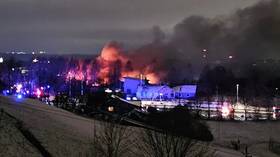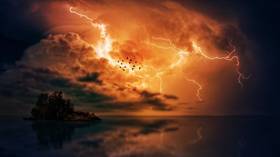Beirut explosion likely a catastrophic ‘accident similar to 2001 Toulouse fertilizer factory blast,’ detonations expert tells RT
The massive blast that shook Beirut was likely caused by a fatal mishandling of hazardous materials, mirroring an explosion that leveled a fertilizer plant in France some two decades ago, a chemist and detonations expert told RT.
Tuesday’s explosion tore through a port chemical depot and sent a towering fireball and mushroom cloud into the sky over Beirut, leaving more than 70 people dead and some 4,000 injured. Though US President Donald Trump has mused that the incident was an “attack” caused by “some kind of bomb,” Frolov – who heads the combustion and explosion department at the Semenov Institute of Chemical Physics of the Russian Academy of Sciences in Moscow – said he’s confident the blast was a catastrophic accident.
#BeirutExplosion | 15 camera angles synced pic.twitter.com/4iRje42Jdb
— RT (@RT_com) August 4, 2020
“The sequence of events shows this was an accidental explosion for sure,” Frolov, who also leads the Semenov Institute’s detonations lab, told RT in an interview. “You shouldn’t store such amounts of hazardous materials in one place. This is forbidden.”
Also on rt.com ‘A bomb of some kind’? Trump says US military officials think deadly Beirut blast was an ATTACKIf you have hazardous materials somewhere in store, and if you violate the conditions of storage, you can expect an ignition source will always appear.
While the exact cause of the blast has yet to be determined, Lebanese officials say that some 2,750 tons of ammonium nitrate had been improperly stored at the port for nearly six years, with the country’s President Michel Aoun vowing “severe penalties” for those responsible for the chemical cache. Commonly used in fertilizers, ammonium nitrate is also the main ingredient in some industrial-grade explosives, such as ANFO, and is prone to violent combustion if stored under the wrong conditions.
Frolov pointed to press reports stating that the chemical warehouse was located not far from a fireworks storage and other hazardous material facilities, calling it a “very, very dangerous mix,” requiring only a small spark to set off a major secondary blast.
Fireworks can be seen clearly in this video https://t.co/Z2DMT0JNbspic.twitter.com/fXZgMbJ0EV
— Ali (@allushiii_new) August 4, 2020
“It could be static electricity, it could be an open fire, a cigarette… it could be a shock or electrical discharge, even some lightning,” he said, as officials have yet to confirm what caused the initial blaze. Some local reports, citing security sources, alleged it could be a welding mishap.
This accidental ignition source will cause a fire, and during the fire you have some gasification of the existing material, and the accumulation of these combustibles in the atmosphere... You have escalation of fire, and then you can have the secondary explosion.
Recalling the 2001 disaster at a fertilizer factory in Toulouse, France, where some 300 tons of ammonium nitrate combusted, leveling the entire facility, Frolov said the two deadly blasts are comparable in destructive force, estimating the Beirut explosion to be equal to “tens of tons of high explosives.”
Also on rt.com Ticking time bomb? Explosive stash that devastated Beirut was there since 2014, PM says, vowing to punish those responsible“What I saw reminded me of the explosion in Toulouse. There were very similar consequences,” Frolov said, noting that the 2001 blast was equivalent to 20 to 40 tons of TNT. “In that explosion about 30 people were killed immediately, and about 3,000 were injured. So this gives me an exact parallel, that this explosion is very close, by its strength, to that one.”
Frolov also refuted speculation and concerns over a huge “mushroom-shaped cloud,” explaining it was common in the case of such a powerful conventional explosion. “This is actually the explosion itself… There was some special shape, and this shape is characteristic of very strong explosions, where you have not a spherical wave, but the wave with a ‘mach stem’ it is called… near the ground.”
This is not a Hiroshima-like [blast] like some people say, because there were kilotons [in that case], but here’s tens of tons.
As first responders in Beirut work through the night to pull survivors from the rubble, and investigators pinpoint the precise cause of the blast, Frolov said the tragic incident will come as “a very, very large and sad lesson for everybody,” stressing the need for proper storage of volatile and dangerous chemicals.
Also on rt.com WATCH huge mushroom-like cloud cover Beirut’s docks area after ‘fireworks depot’ explodesSubscribe to RT newsletter to get stories the mainstream media won’t tell you.














